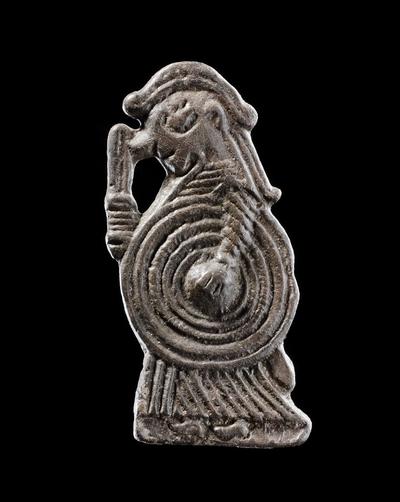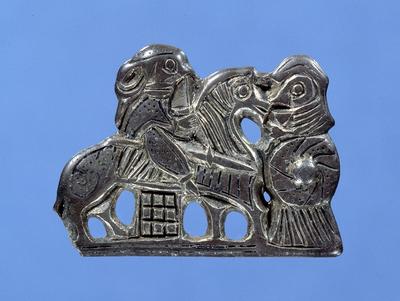Viking shields
The type of shield used by the Vikings can be traced back to the Iron Age. It consists of thin planking, which forms a circular shape. In the middle is a dome of iron to protect the shield bearer’s hand. This is called the shield boss and is often the only part which is preserved after 1000 years in the ground. The date of a shield can be established from the form of the shield boss, which varied throughout the Iron Age and the Viking period. Shield bosses are often found in graves, in which shields accompanied the dead on their final journey.
A rare find
A rare find was made at Trelleborg, near Slagelse, in 2008. Archaeological excavations at the site uncovered an almost complete shield. This is made of pine wood and has a diameter of around 80 cm. Presumably the shield was used when the fortress was in operation at the end of the 900s. This is only the second site from Scandinavia that has produced one or more complete Viking shields. The shield was found in waterlogged conditions – which have resulted in it still being preserved today. It has a hole in the middle and a grip is also present. Originally a boss must have been attached in this part of the shield, but it was not found in the excavations.


64 shields in a grave
The most impressive collection of complete Viking shields was recovered from the Norwegian burial at Gokstad. Here a ship was buried, together with a prince or king and large numbers of grave goods. Amongst these were 64 round shields painted with yellow and blue paint.
The shields are relatively thin, and research has shown that they would split easily when struck with arrows, axes and swords. It is therefore thought that they were originally covered with animal skin, which shrinks slightly when it dries out, thus increasing the strength of the shields. The addition of animal skin also meant that the shields were less lightly to split, and thus relatively thin pieces of wood could be used to keep their weight down.
We are also familiar with Viking shields from the art of the period. Various picture stones from the island of Gotland show armed warriors with shields that appear to be painted. Some of the small, valkyrie figures also carry decorated shields.
Shields at sea
The Skuldelev 5 warship from Roskilde Fjord has given us valuable knowledge about how shields were mounted on the side of a ship. Along one side of the ship the remains of a so-called shield rack are preserved. Shields could be placed in this longitudinal attachment to protect the crew against incoming spears and arrows.
Test sailings with a similar shield rack have, however, demonstrated that a ship’s sailing capacity is reduced considerably when shields are mounted along its side. It is therefore probable that the shields were not mounted until immediately before military action.

